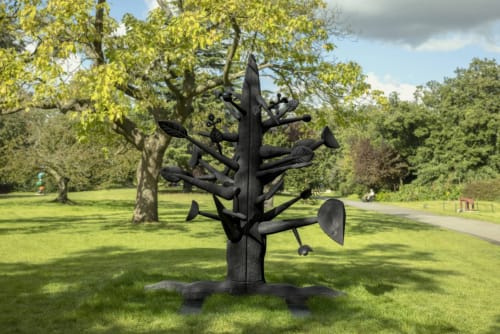The Frieze Sculpture Park is by far the most accessible element of the Frieze art fairs, which return in October and are essentially an art world event. Yes, these works are being presented by commercial galleries, and yes, they’re for sale. But because they’re selected by Clare Lilley, the director of programme at Yorkshire Sculpture Park, who has the experience to understand what works and what doesn’t in the open air, they form a coherent group despite their disparate appearance.
There are sub-plots within Lilley’s selection. Annie Morris’s stack of hand-sculpted lumpy balls, cast in bronze and painted in high colour, riff on the nearby Muamba Grove sculptures by Vanessa da Silva. The works share organic and bodily forms but they’re distinct in mood, material and energy – Morris’s a weighty and fragile stack, da Silva’s confectionary-toned, light and loose, as if the forms are caught mid-dance. Then, the oval voids within Da Silva’s work find a rhyme in those of Solange Pessoa’s soapstone forms, like flattened skulls or enlarged pebbles with holes hewn by nature.
Another grouping plays with architecture: Anthony Caro’s Palanquin was made when he was playing with structures bordering on habitable spaces, but existing on the edge. The South African practice Counterspace are showing a fragment of their Serpentine pavilion, a black plywood structure which is like a bench, a table and a standalone sculpture in one. And Carlos Cruz-Diez’s circular pavilion of coloured glass creates an enveloping world of colour, like living in a stained glass window.
Lilley has chosen works that run the gamut of sculptural materials. There are the highly manufactured aerospace technologies of Gisela Colón’s Quantum Shift (Parabolic Monolith Sirius Titanium), a shiny rocket in sensual tones. Nearby is Isamu Noguchi’s Play Sculpture made from off-the-shelf curved sewer pipes fashioned into a bright red undulating form – jungle-gym minimalism. Other works using repurposed material are more sinister: Jorge Otero-Pailos has taken the security fence that surrounded the U.S. Embassy in Oslo after 9/11 and transformed it into a sculpture that from some angles resembles a drawing in space and from others looks like the contorted metal left after bombings. Up in a tree nearby, Tatiana Wolska has recycled plastic bottles into red amorphous forms that hover like clouds of poison amid the branches.
The quality of work in the sculpture park is always uneven, but it’s never less than engaging. And then there are always those moments of delight where park and art meet: in the pristine sheen of Colón’s monolith, the surrounding squat, deciduous trees are reflected as elegant cypresses. You’d never see that in a gallery.


